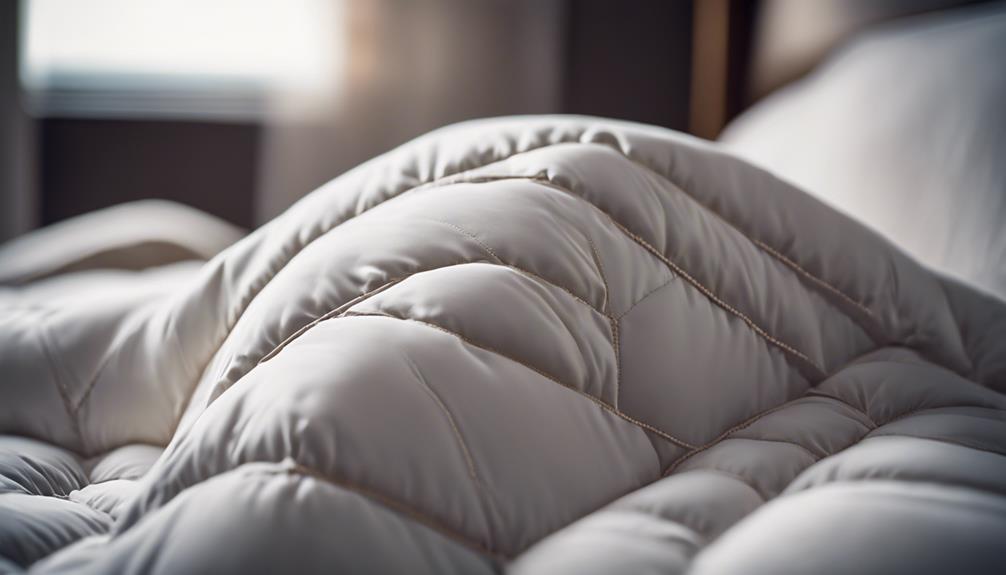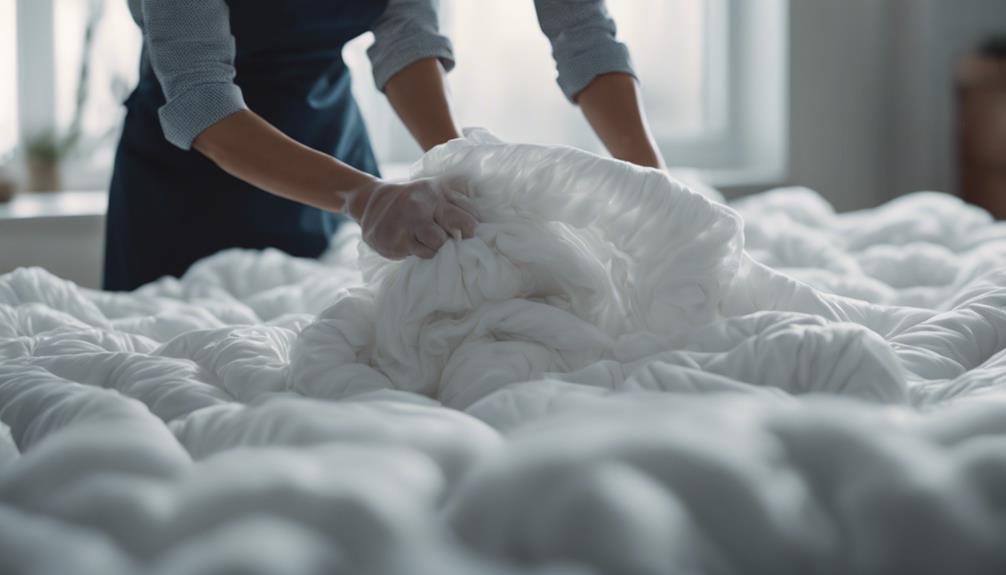Washing a comforter in a washing machine with an agitator is possible. To ensure the fabric is not damaged, select a gentle cycle and avoid overloading. Using a mesh bag for protection is recommended. Choose a delicate cycle and slow spin speed to maintain the comforter’s filling and shape. Adding white vinegar can act as a natural fabric softener and help eliminate odors. For faster drying, use the extra spin cycle. When tumble drying, opt for low heat and use dryer balls. Make sure the comforter is thoroughly dried before storing it. Always follow the care label instructions. For more detailed tips on washing a comforter with an agitator, click the link below.
Key Takeaways
- Consider fabric impact from machine agitation and opt for gentle or delicate cycles.
- Use a mesh laundry bag for protection and avoid overloading the machine.
- Follow care label instructions for washing a comforter in a machine with an agitator.
- Ensure thorough cleaning with a delicate cycle and slow spin speed.
- Preserve comforter filling and shape by selecting appropriate settings and using white vinegar for maintenance.
Washing Comforter With Agitator: Considerations

When washing a comforter with an agitator, it's important to consider the potential impact of the machine's agitation on the delicate fabric. It's crucial to follow the care label instructions provided by the manufacturer. Opt for a gentle or delicate cycle on the washer to minimize the stress on the comforter.
Overloading the machine should be avoided to prevent excessive wear and tear during the wash cycle. For added protection, consider placing the comforter in a mesh laundry bag before placing it in the washer with the agitator. This simple step can help shield the fabric from direct contact with the agitator, reducing the risk of damage.
Delicate Cycle and Slow Spin Speed

When washing a comforter with an agitator, it's important to select the delicate cycle to safeguard the fabric. Opting for a slow spin speed guarantees that the comforter isn't overly agitated during the wash.
These settings help preserve the filling and shape of the comforter, extending its lifespan.
Gentle Cycle Importance
Using the delicate cycle and selecting a slow spin speed are essential steps when washing a comforter with an agitator to ensure gentle care and thorough cleaning. The gentle cycle is designed specifically for delicate comforters, ensuring they're cleaned effectively without causing damage. Paired with a slow spin speed, it helps maintain the integrity of the comforter's fabric and stitching, preventing excessive wear.
Low Spin Benefits
To guarantee the delicate comforter fabrics are protected during washing, selecting a low spin setting on the delicate cycle is essential. The low spin speed reduces stress on the comforter's filling and stitching, preserving the fabric's quality.
The gentle agitation from the agitator in the washing machine ensures thorough cleaning without causing damage. By using a low spin setting, the comforter's shape and fluffiness are maintained post-wash.
Opting for a delicate cycle with a low spin speed is ideal for washing comforters with an agitator to preserve their overall quality. Remember, the key is to handle the comforter with care to maintain it in great condition for a longer period.
Using White Vinegar Instead of Fabric Conditioner

White vinegar can be a versatile alternative to fabric conditioner when washing a comforter with an agitator. It helps soften fabrics, reduce static cling, and eliminate odors without leaving residue behind.
Benefits of Vinegar
In place of traditional fabric conditioners, we benefit from using white vinegar as a natural alternative in washing comforters with an agitator. White vinegar acts as a natural fabric softener, breaking down detergent residue to leave comforters clean and fresh. It also helps eliminate odors and bacteria that may be lingering in the fabric.
By using white vinegar in the rinse cycle, you can prevent mineral buildup in the comforter, allowing for better absorption of water and detergents. Additionally, the acidity of vinegar works to maintain the fluffiness and integrity of the comforter's filling over time.
Making this switch can lead to a more effective and eco-friendly way to keep your duvet clean and comfortable.
Application Tips
For best results when washing a comforter with an agitator, consider incorporating white vinegar as a natural alternative to traditional fabric conditioners. White vinegar can act as a fabric softener, helping to soften the comforter's fabric, reduce static, and eliminate odors effectively.
Adding 1/4 to 1/2 cup of white vinegar to the fabric softener dispenser or during the rinse cycle can provide excellent results. This natural alternative is especially beneficial for individuals with sensitive skin or allergies, as it's gentle on the fabric and skin.
Additionally, using white vinegar instead of fabric conditioner is an eco-friendly approach to laundry care, as it's cost-effective and leaves no residue behind. Give it a try for a fresh, soft, and clean comforter after every wash.
Extra Spin Cycle for Faster Drying

Using the extra spin cycle in a washing machine with an agitator can greatly speed up the drying process for items like comforters. This feature is particularly beneficial for bulky items, as it helps in moisture extraction, leading to faster drying times. Let's explore how utilizing the extra spin cycle can improve the overall comforter washing experience in agitator machines.
| Features | Benefits |
|---|---|
| Faster Drying | Reduces drying time for comforters |
| Energy Efficiency | Decreases energy consumption during drying |
| Improved Efficiency | Enhances washing efficiency for bulky items |
| Moisture Extraction | Helps extract more moisture from the comforter |
| Drying Enhancement | Practical way to improve comforter washing process |
Tumble Drying on Low Heat

We recommend tumble drying the comforter on low heat to maintain its fluffiness and prevent damage. Using a dryer on low heat settings is important to prevent excessive shrinkage and preserve the comforter's material. Additionally, low heat helps guarantee even drying without compromising the comforter's quality. For best results, consider using dryer balls during the tumble drying process. These balls can help redistribute the filling inside the comforter, leading to a more fluffy end result. It's vital to avoid high heat settings, as they can potentially damage the fabric or filling of the comforter.
To achieve the best outcome, make sure the comforter is completely dry before storing it away. This step is crucial in preventing mold or mildew growth, which can occur if the comforter is stored while still damp. By following these guidelines and using low heat settings when tumble drying, you can help maintain the fluffiness and quality of your comforter while preserving its material for long-lasting use.
Ensuring Full Drying Before Storage

To guarantee the comforter is fully dried before storage, it's important to wait until it's completely dry to prevent mold and mildew growth. Here are some steps to ensure proper care and maintenance of your comforter:
- Use a large capacity washer to allow the comforter to move freely during the wash cycle.
- Opt for a gentle spin cycle to prevent damage to the comforter's fibers.
- Consider using a fragrance-free detergent to avoid leaving any strong scents on the comforter.
Proper drying is essential in preventing mold and mildew, preserving the fluffiness of the comforter, and maintaining its freshness. If using a dryer, make sure the comforter is completely dry before storing to prevent musty odors.
Alternatively, hanging the comforter to air dry fully can be an effective method if a dryer isn't available. Adequate drying time is key to ensuring that the comforter is ready for use and stays in top condition for a longer period.
Preventing Damage to the Comforter

To prevent damage to the comforter during washing, make sure it's evenly distributed in the washer. Uneven distribution can lead to excessive agitation, potentially causing tears or damage to the comforter.
Avoid overloading the washer to allow the comforter to move freely during the wash cycle. Using a gentle or delicate cycle on the washing machine can help minimize stress on the comforter fabric.
Before washing, check the comforter for any tears or loose seams that could worsen during washing. If you're using a top load washer with an agitator, consider placing the comforter in a mesh laundry bag to protect it from excessive agitation.
These steps are essential in preventing damage to the comforter and ensuring it comes out of the wash in good condition. By following these guidelines, you can maintain the quality and longevity of your comforter when using a washing machine with an agitator.
Maintaining Fluffiness of the Comforter

To maintain the fluffiness of the comforter, one should use dryer balls or tennis balls during the drying process. These items help to keep the comforter fluffy and prevent clumping by agitating it gently while it dries.
When drying the comforter, consider the following tips:
- Use a large capacity dryer or a machine with enough capacity to accommodate the comforter without overcrowding. This allows the comforter to move freely and maintain its fluffiness.
- Opt for a bulky or bedding cycle on the dryer to make sure the comforter is dried thoroughly and evenly.
- If using tennis balls, make certain they're clean to avoid transferring any dirt or debris onto the comforter during the drying process.
Remember to use a mild laundry detergent, fluff the comforter periodically during drying, and consider air drying it partially before using the dryer to help preserve its fluffiness.
Importance of Care Label Instructions

Care label instructions play an important role in guiding the proper care and maintenance of a comforter when washing it in a machine with an agitator. These labels provide specific guidance on water temperature, cycle settings, and detergent recommendations tailored to the fabric and filling of the comforter. Following the care label instructions is vital to guarantee effective cleaning and prevent damage to the comforter. Ignoring these instructions can result in improper cleaning, loss of fluffiness, or even shrinkage of the comforter.
To maintain the quality and longevity of your comforter, always refer to the care label before washing it in a machine with an agitator. By adhering to the recommended water temperature, cycle settings, and detergents, you can keep your comforter clean and fresh without compromising its integrity. Proper cleaning based on care instructions not only preserves the appearance and feel of the comforter but also prolongs its lifespan, saving you money in the long run.
Frequently Asked Questions
How Do You Put a Comforter in the Washing Machine With an Agitator?
When washing a comforter with an agitator, it's important to spread it evenly in the machine for proper cleaning. Make sure there's enough room for the comforter to move freely without bunching up.
Avoid overloading the machine to allow for effective agitation during the wash cycle. Opt for a gentle or delicate setting to prevent damage to the fabric or fill.
Periodically check the comforter to make certain it's moving well with the agitator.
Will an Agitator Ruin a Comforter?
Yes, an agitator can potentially ruin a delicate comforter. The spinning motion may cause tearing or tangling, leading to uneven cleaning. It's advisable to use front-load or top-load washers without agitators for washing comforters.
Extra caution and care are necessary when using a machine with an agitator. Agitators are better suited for heavy-duty fabrics like towels or jeans. It's important to choose the right washer to prevent damage to your comforter.
Can You Wash a Queen Comforter in a 4.5 Cu Ft Washer With Agitator?
Yes, a queen comforter can be washed in a 4.5 cu ft washer with an agitator, but it may not provide ideal cleaning due to limited space for movement. Larger capacity washers, like those with 5.0 cu ft or more, are recommended for better results.
Overcrowding the washer can lead to ineffective cleaning and potential damage. Consider using a commercial washer at a laundromat for oversized comforters if your home washer is too small.
Can You Wash a Blanket With an Agitator?
Yes, we can wash a blanket in a machine with an agitator.
Agitators can be effective at cleaning but may cause more wear on delicate fabrics. It's important to follow care instructions and use a gentle cycle to prevent damage.
Larger blankets mightn't get evenly cleaned due to limited space. Be cautious of potential damage or tangling during the wash cycle. Consider the fabric type and washing machine capacity for best results.
Is It Safe to Wash a Comforter in a Washing Machine With an Agitator?
Washing comforter with agitator can be risky, as the agitator may damage the fabric or fillings. Check the care label for specific instructions. If the comforter is too large for the washing machine, it’s best to use a commercial-size washer or opt for professional cleaning instead.
Conclusion
To sum up, washing a comforter in a washing machine with an agitator is possible with proper care and precautions. By following the recommended steps such as using a delicate cycle, white vinegar instead of fabric conditioner, and ensuring full drying before storage, you can keep your comforter clean and fluffy.
Remember, proper maintenance is key to prolonging the lifespan of your comforter. So, why not give it a try and keep your bedding fresh and cozy?









